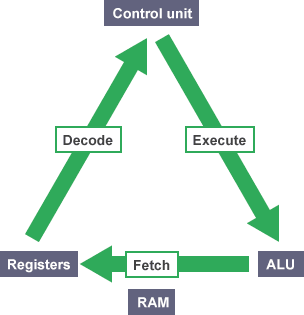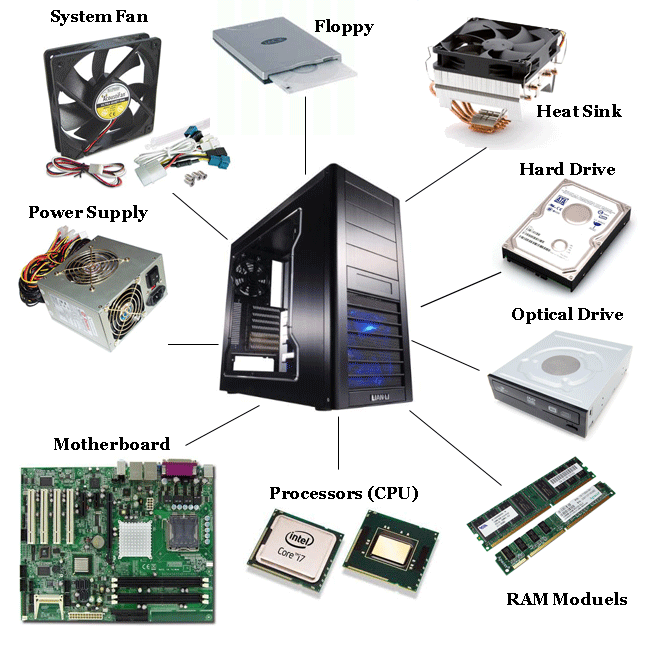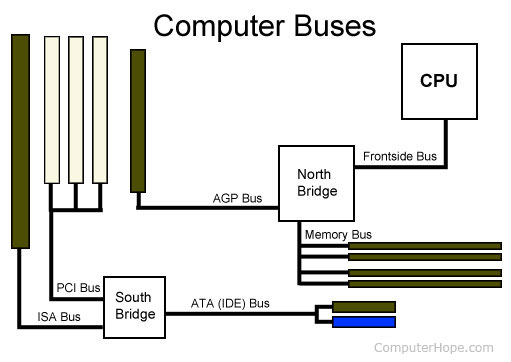Discuss The Fetch Execute Cycle And Different Parts Of The Computer System
Question
Task: Give detailed description of how fetch execute cycle using which a computer recovers instructions from its memory, while explaining the function and importance of various components and peripherals.
Answer
Computer science deals with a number of concepts and commands, and one of them is fetch execute cycle. The primary operation cycle of a computer system is known as fetch execute system. The central processing unit (CPU) is a design that helps understand a given set of instructions. The fetch execute cycle of CPU reads the computer's main memory to execute the given instructions. The cycle continues from the time computer boots up till it shuts down.

One can give a number of instructions to his computer, but the processor can only work on one instruction at a time. When one instruction is completed, the processor starts to work on the next instruction, and this cycle continues until all the instructions have been performed and this continuous cycle is known as fetch execute cycle (Reinman, Calder and Austin, n.d.).
The present report on the fetch execute cycle will discuss the computer hardware and different concepts related to the computer system. There will be a discussion about processors, input and output devices, primary and secondary memory, networking, and other elements that help the computer function.
Processors are considered as the heart and brain of a computer system. It is a part of the system which helps in processing and storing of data and instructions. It acts as a medium of communication between all the other parts of the computer (Morris, 1985). The processor has a major role to play in the form of fetch execute cycle in the hardware, RAM and memory of a computer.
Central Processing Unit
The central processing unit or the CPU is an important part of a computer system, and without it, the latter cannot function. The main function of the CPU is to read instructions given to a computer system. These instructions are given to a computer system in order to decode some data from different programs stored in the system. When performing its fetch execute cycle function, the central processing unit has to adopt four basic processes which are fetched, decode, execute and store.
How does fetch execute cycle work in a CPU?
When the CPU receives certain information, it applies its fetch execute cycle function and searches all the programs and decodes the instruction received and processed the request. The instructions received have an address which is used by the processor to decode the instructions from a program counter. CPU cannot execute each and every instruction it receives; it is the responsibility of the program counter to check the instructions being received by the CPU (Fuchs, 2013). The program counter basically helps in tracking the instructions received from the memory of the computer.
Stages which can be found in the fetch execute cycle
Decode: When an instruction has been requested from a computer, the CPU receives the instructions and decodes it so that it could be executed. There are some central processing units that can understand a given instruction differently; for example, the instruction related to assembly code should be decoded as a binary instruction.
Execution: Once the instruction has been decoded, the fetch execute cycle has to look through the memory in order to perform the function, for example, a command to delete can be given only when the previous instruction given to the CPU has been performed.
Store: Once the function of execution has been performed, the central processing unit proceeds with writing the results on the primary memory. Later on, the data which is generated that is the output of the instruction performed is written on the memory.
Register: After the instructions have been processed by the processor, the data gets stored in the memory of the computer, which is called a register. The processor installed in a computer depends upon the number of instructions it can register in its memory. There are different types of registers, and some of them are named as accumulator register which helps in storing mathematical and logical instructions, status register which helps in checking the status of the system, instruction register which contains the real-time instructions and ordinal counter which stores the next instructions (Klauser and Grunwald, n.d.).
Microprocessor: It is a circuit containing millions of small switches combined on a micro silicon chip referred to as transistors. It helps in storing or manipulating data on the microscopic lines. The circuit can copy a patterned data which can be programmed by different software’s so that the system can perform different tasks.
Graphics processing unit: The GPU is a processor which functions on a similar line like the CPU. The processor in GPU is based on a single chip. The primary function of the graphics processing unit is to compute 3D functions, whereas the central processing unit is considered as the brain of the computer system. The GPU helps in giving lighting effects, transforming the objects and providing a 3D movement (Oberoi and Sohi, n.d.).
Forms of memory
Memory is divided into two parts, namely primary and secondary. Primary memory forms one of the prioritized parts of a computer, and without a memory, the CPU cannot complete the fetch execute cycle. When the processor of a computer receives information or is asked to retrieve any information, the same is done through memory. The information is retrieved by the CPU from the random access memory (RAM). CPU can access memory from the RAM to read and store data. RAM is one of the usual types of memory, where data can be stored and retrieved. RAM can read the data stored in the memory, and it can even write data into the memory, and both the function is done through electrical signals. But random access memory also has a volatile character that can be seen in case of failure of power, leading to loss of data as the RAM has a feature to temporarily store the data (Oberoi and Sohi, n.d.).
RAM is further divided into two types, namely DRAM and SRAM. The dynamic memory (DRAM) is made of cells in order to detain the data as a charge on the capacitor. DRAM gets functional in the main memory of a computer. The static random access memory (SRAM) consists of many thousands of flip-flop circuits. SRAM is considered as one of the most expensive and fastest memories to read and write. It is also fast on the chip cache memory. As compared to DRAM, it uses less power, which makes it the right choice for machines charged through battery or portable devices.
Read-only memory: It contains some type of data which cannot be changed or modified. To maintain the bit value in the memory, the ROM does not require any power supply. The data in the read-only memory cannot be edited or rewritten. The data in the ROM does not require being stored other than the main memory.
Cache memory: The memory which is placed between the main memory and the central processing unit is known as cache memory. While working on the system, the microprocessor of the computer gets access to some memory at a comparatively faster pace than the RAM. There are times when the microprocessor cannot find the data processed by it, and in such situations, the data is stored in the cache memory. The memory in the cache makes the system slow and affects the speed of the processor. At times the cache memory gets closely placed to the microprocessor (Klauser and Grunwald, n.d.). For example, the L1 cache can be found on a microprocessor chip, and L2 cache is different from the RAM chip. The time taken to transfer information may also increase in case there is cache memory in the system.
Virtual memory: It is one of the common storage places located in every computer and operating system. A small microprocessor, as well as a supercomputer, can have virtual memory. In reality, there is no physical existence of virtual memory, but its feature helps in compensating shortage of memory. It temporarily works by transferring large data and files from the RAM to disk storage. When a program is loaded, there is a change in the amount of the local memory.
Secondary memory: It is one of the slowest and reasonable forms of memory that a person can buy. The secondary memory data gets stored permanently, and it requires human intervention to erase the data from it. But this form of memory cannot function on its own; it involves a manual intervention wherein the data from the primary storage needs to be copied on it. There are different forms of secondary memory like magnetic disks, magnetic tapes and optical disks.
Magnetic disks: As the name suggests the data on a magnetic disk gets stored on the disk. The users can store any amount of data on these magnetic disks, which can be erased as per their preference. Some of the examples of such disks are hard drives and floppy disks. The hard disks are faster and capable of storing a greater amount of data than a floppy disk.
Optical disk: The data in the disk gets stored through burning microscopic holes with the help of laser on the surface of the disk. When in need of reading the data stored on the disk, a second laser is used to reflect on the holes which detect the data (Fuchs, 2013). Most of the optical disks are in a readable format as they come in with a previously filled data. The disk data can be read, but no modification or deletion can be made in the disk.
Input and output elements for users and networking
A computer system consists of different input and output elements and without which it cannot function appropriately. Usage of devices depends upon the kind of data you want to feed into the system. When a data is fed in the system, then it is obvious that there will be a generation of output and the generated output can be displayed on a computer screen or a page of the printer or heard as audio.
These input and output devices can be used by the user or the network. Some of the input elements for users are discussed below:
Keyboard: It is one of the most important input elements of a computer system. It helps in entering text which gets displayed on the screen of the system. If connected with a mouse, it can also help in generating commands like opening any of the data files, applications, etc. A keyboard consists of alphabets, numbers, editing and functioning keys, etc.
Mouse: It is one of the smallest and common input devices attached to a computer in order to point out something. There is a ball beneath the mouse which helps in rolling on flat surfaces. The rolling thereby lead the cursor on the screen of the computer to move around. The mouse can help in pointing at the next step that you want to do on the computer. There are different keys on the keyboard which can also help in moving the cursor (Reinman, Calder and Austin, n.d.).
Scanners: It is a device used to scan images. It copy’s image from the source and pastes it on the screen of the computer in the form of a digital copy. During conversion, it functions on numerical lines of the original image and generates a digital copy of the image having the same colour. Usually, scanners are used to scan graphics, but it can also be used to scan pages having text with the help of optical character recognition (Morris, 1985).
Trackball: It functions as a mouse, but it is basically used while playing online video games. It is an upside-down mouse, and the ball placed on it can be rolled directly with the hands.

Some of the output elements for users are discussed below:
Printers: Printers are commonly used to print out some data from the computer. The inkjet printers are one of the common forms of printers used to generate hard copies of data required. The printers have ink which is sprayed on a blank page. It is necessary to check the availability of ink before giving a command to the printer. Laser printers are also in demand these days due to its high-quality output which can be seen in image files.
Speakers: Speakers, as the name suggests, are used to producing sound. It can be used to produce a beep or to hear the sounds of the games and music. The motherboard also has some sounds, but they are very basic, but if you want to hear some high-quality sound, speakers are the best option to look for. The speakers can be connected to the system.
Networking elements are some devices to establish communication between hardware and the computer network. Some of the networking elements are discussed below:
Hub: It establishes a connection between multiple networking devices on the computer. The hub helps in repeating commands which could not be performed due to low signals. It is a simple device which helps in connecting the components of LAN with other similar protocols. If the hub's setting is properly configured, it can be used on digital and analog data; for instance, if the hub receives a digital data, it must process it as packets, and if it receives an analog data then it must process it as signals.
Switch: It has a better role to play compared with the hubs. It is a multipurpose device to make the network more efficient. It generates specific routing information in the internal network about the nodes through hubs and routers. It helps in connecting strands of LAN and is able to send the incoming hardware addresses to its destination. It also helps in securing the network and can work as a switch and a router.
Router: It helps the packets reach their destinations through interconnected networking devices using divergent network topologies. Routers can store information related to the network it is connected with. It also serves as a connection between LAN and WAN. They can be used to separate internal networks and help them function independently. They can also act as a defence mechanism and let go only those network administrations that are authorized to do so.
Modem: With the help of modem, digital signals can be transmitted over analog telephone lines. The signals received are converted into different frequencies and transferred to the location. When the modem at the location receives the signal, it functions in a reverse manner and generates a digital output on the computer. It is used by a number of cable operators for home and personal uses.
Support elements of a computer
As the term suggests, support elements of a computer help the system in its operation. These elements help in increasing the performance of the computer, save it from failure due to overheating and help it in functioning. Some of these elements are as follows:
Buses: It is a set of connections in the physical form like that of a cable, which helps in communication and is divided among different hardware components. The aim of the system bus is to make communications through an individual data channel by limiting other pathways which may be required for communications purposes.

Fiber cable: These are some cables made up of fiber optics. They are transparent glass tubes which reflect light from the system. The light travels through the tube, making a straight line.
Fans: It is one of the major parts of the computer. CPU also has a fan, and it helps in cooling the processor of the computer and protects it from overheating, which may damage the other parts of the system. It reduces the outflow of hot air and controls the circulation of hot air around the computer. These fans are available in different sizes.
Motherboard: It is an element which holds all the components of a computer together. Electric signals are passed through the system with the help of the motherboard, and without it, a computer cannot work.
Conclusion
It can be said that a computer is made up of different elements which include processor, input and output devices, memory, etc. The processor has a major role to play in the computer system, and it is considered as its brain. CPU is the main processor which functions by using the fetch execute cycle. Memory is divided into two parts primary and secondary. Primary memory is the main memory which is used by CPU to access information, and the secondary memory can store informations.
Reference
Reinman, G., Calder, B. and Austin, T., n.d. Fetch execute cycle directed instruction prefetching. MICRO-43. Proceedings of the 43rd Annual ACM/IEEE International Symposium on Microarchitecture,.
Morris N.M. (1985) The CPU and its Fetch Execute Cycle. In: Microelectronic and Microprocessor-based Systems. Palgrave, London. https://doi.org/10.1007/978-1-349-06978-1_3
Fuchs, G., 2013. Poster abstract: ASFECs. Proceedings of the 1st international conference on Information processing in sensor networks - IPSN '13, [online] Available at:
Klauser, A. and Grunwald, D., n.d. Instruction fetch execute cycle mechanisms for multipath execution processors. MICRO-43. Proceedings of the 43rd Annual ACM/IEEE International Symposium on Microarchitecture, [online] Available at:
Oberoi, P. and Sohi, G., n.d. Out-of-order instruction fetch execute cycle using multiple sequencers. Proceedings International Conference on Parallel Processing, [online] Available at:












